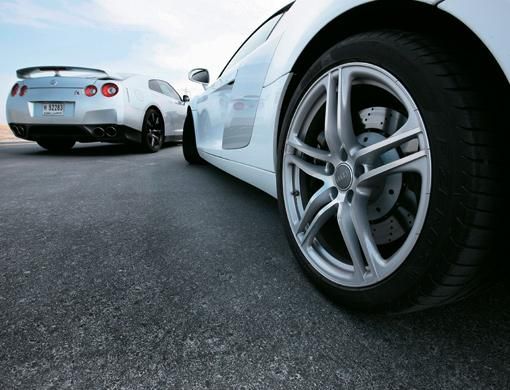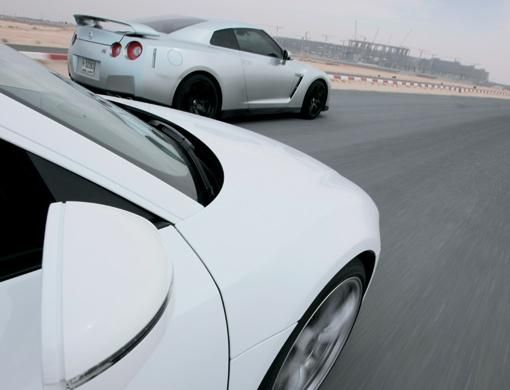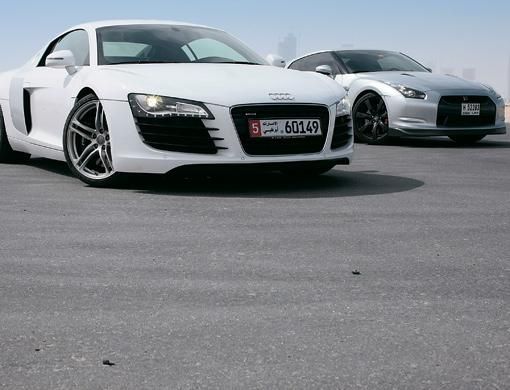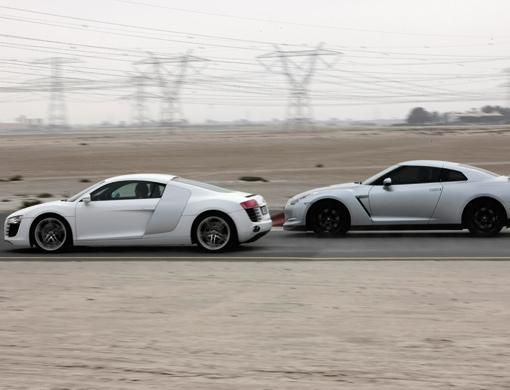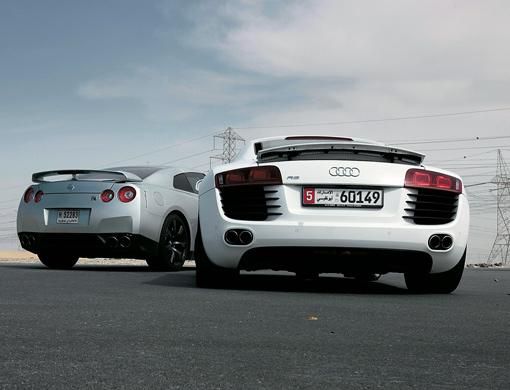The Audi R8 and Nissan GT-R have each, in their own ways, re-written the supercar rulebook. But what happens when they take each other on? Tom Allen, on the R8, and Amit Benjamin, on the GT-R, tell you.
Remember 10 years ago when you first saw the Audi TT? Although the looks were an acquired taste, for most, they tasted good. It managed to be cute yet cutting edge; futuristic yet stylish, and will probably be cited as a car which defined the Nineties zeitgeist in years to come.
Remember 10 years ago when you first saw the Audi TT? Although the looks were an acquired taste, for most, they tasted good. It managed to be cute yet cutting edge; futuristic yet stylish, and will probably be cited as a car which defined the Nineties zeitgeist in years to come.
But it was just a 2+2 coupé, based on the A4 and packing a Quattro all-wheel drive 1.8 turbocharged inline four. So it was hardly earth-shattering mechanics.
The TT was a design revelation, not revolution. The R8, however, when it first arrived three years ago, was. There was the same shiver-down-the-spine visuals but with more meat on the R8's bigger bones. It packed all the TT's revelatory design punch, matched by the entire car.
It borrowed its Gallardo cousin's transmission and chassis true supercar ingredients. But it eschewed the Gallardo's 5.0-litre V10 its own V10 would come later (see previous issue for details!). Instead, it used Audi's own 4.2-litre V8 FSI. Okay, it's taken from the RS4 but is heavily modified.
And the vital statistics eclipse the mid-engine's quotidian origins: 0 to 100kph in 4.6 seconds, with a maximum output of 414bhp at 7,800rpm. That's slower and less powerful than the GT-R, but it's hardly embarrassing.
Like the GT-R, much is made of the car's fetishist production. Audi says the car is made up of 5,000 unique parts. Each of the fifteen cars made daily at Audi's Wolfsburg plant is scanned by 95 lasers in under five seconds to ensure 220 measurements are within 0.1mm. So what if it drives like a wheelbarrow? Luckily, though, it doesn't.
And, bizarrely, its striking looks are relevant in appraising its handling and performance because, somehow, the car feels like it looks. There is a drop-of-mercury quality to the R8's streamlined appearance.
Depress the accelerator and the car feels like you're driving the future. It's incredibly planted and balanced, and lets the driver feel the whole car through the steering wheel. The steering feels as laser guided as the car's construction, helped by the Quattro all-wheel drive, which doesn't take the edge of the experience.
In fact, it encourages you to take corners with ever more abandon, as you revel in the car's lightness yet solidity. The magnetic dampers and ceramic and carbon fibre-reinforced brakes, Brembo caliper discs clamping all four wheels add to the controlled feel.
The novel metal gate gearstick indicates the manual R-tronic transmission beneath. But this is where the first of a couple of R8 Achilles heels kicks in. The single-clutch semi-automatic sequential is surprisingly and disappointingly awful.
Picture youself at the R8's wheel, waiting at a traffic signal on a road without speed limits. The light is red and so are the brake lights of the GT-R alongside you.
You've put the Audi in sport mode and turned off the EPS. You've kept the car in first by keeping your foot on the brake. (Take your foot off and the car doesn't crawl but it does automatically slip you into neutral after a few minutes bad if you happening to be preparing to race the GT-R from the lights&) The signal turns orange and you floor it.
The car shouts its revs but from first to second, but then pauses and jolts. Second to third, the same thing: pause and jolt. Third to fourth: pause and jolt. You are actually pushed forward in your seat, not by the G-force but by the gearbox's delay.
And the GT-R? It whistled past you halfway between first to second. So while the V8 R8 is a quick car, albeit 10kph slower than the GT-R, it is hobbled by its woeful gearbox sadly, the same one in its new V10 R8.
The only other flaw, compared to the GT-R is the price. An R8, specc'ed to match the generous base spec of the GT-R, will be at least Dh100,000 more expensive. The R8 came along and undercut the likes of the 911 Turbo, then the GT-R did the same to it.
Where the R8 holds its own is in design. It's prettier outside and inside. But that's cold comfort when the V6 GT-R is giving you a kicking from the lights. Here's how the GT-R shapes up against the V10, which arrives here this autumn. (That a V10 R8 stands a better chance shows how good the GT-R really is.)
The Audi R8 is a thoroughly competent car and, in many ways, better than its exotic cousin, the Gallardo. It's easier to use, more comfortable and more practical around town.
In fact, it has all the upsides of a mid-engined supercar with none of the drawbacks. The Nissan GT-R, on the other hand, is a more unconventional supercar species.
It's front-mid engined, has a boot for your shopping, two rear seats for your kids and a double-clutch auto gearbox that's smooth when you're pootling around town. There isn't a single situation where the GT-R feels anything less than fantastic.
The Audi is easier to manoeuvre around town, thanks to its lighter steering, but on the move, there's little it can do to stop the GT-R from savaging it.
It may pack a bigger 4.2-litre 420bhp V8, but it's hardly a match for the GT-R's 3.8-litre twin-turbo V6, which makes a not unsubstantial 485bhp.
Powering from standstill, the GT-R howls to 100kph in three and a bit seconds, as the German car puffs and wheezes, crudely leaping from gear to gear. Meanwhile, the GT-R throws you back into your seat, swapping cogs with near nuclear precision.
The Audi's 4.2-litre V8 is a superb engine, but, in the R8, it doesn't seem to have on-tap power delivery of the GT-R's V6, which rewards the slightest twitch of your right foot with an instantaneous and extremely satisfying surge.
And it's not just straight-line performance either. I have driven the R8 on a racetrack before and, even though I haven't done the same with the GT-R, I have nary a doubt Godzilla will annihilate the Audi there as well.
Make no mistake, the Audi is supremely sure-footed and flat through the corners with its Quattro all-wheel drive not allowing a smidgen of understeer, but the GT-R is truly on a different planet.
It may be heavier than the R8, but it shrugs off its weight and flies around corners with absolutely no drama.
Driving the R8 and the GT-R back-to-back makes the contrast in performance even more stark. Put the price into the equation and things looks worse for the R8.
The cheapest Audi you can get away with is Dh525,000, while the GT-R, if you forego free insurance and a service contract, is substantially cheaper, at Dh370,000.
Admittedly, the R8 does have some advantages over the Nissan. It's much better looking than the GT-R and, with its mid-engine layout and barking exhaust, it feels like a proper supercar.
The GT-R pales in comparison and feels too ordinary. Moreover, the R8 feels that much better built inside and out. Plus, it's an Audi, so it'll probably outlive its owner.
Another aspect where the R8 has the GT-R licked is charm. While the Jap car, with its plethora of sensors and computers, commands respect, the Teuton is more desirable and organic.
It's extremely likeable so you get smiles and thumbs up from other driver everywhere you go. But when a GT-R arrives behind you, your first reaction is to get out of the way.
Be it performance or every-day usability, the R8 is no match for the GT-R. However, the R8 puts up a good fight. With the GT-R, Nissan went all out to develop a supercar to re-write the rulebook. And it does.
The R8, meanwhile, is a more passionate approach to car building. I felt a fondness for the R8, which I didn't for the GT-R.
And yet, the GT-R is as good as cars get. It was designed to give the automotive aristocracy a bloody nose. Instead, it rips their heads off and eats their nose. Truly, it is a technical coup d'état.


